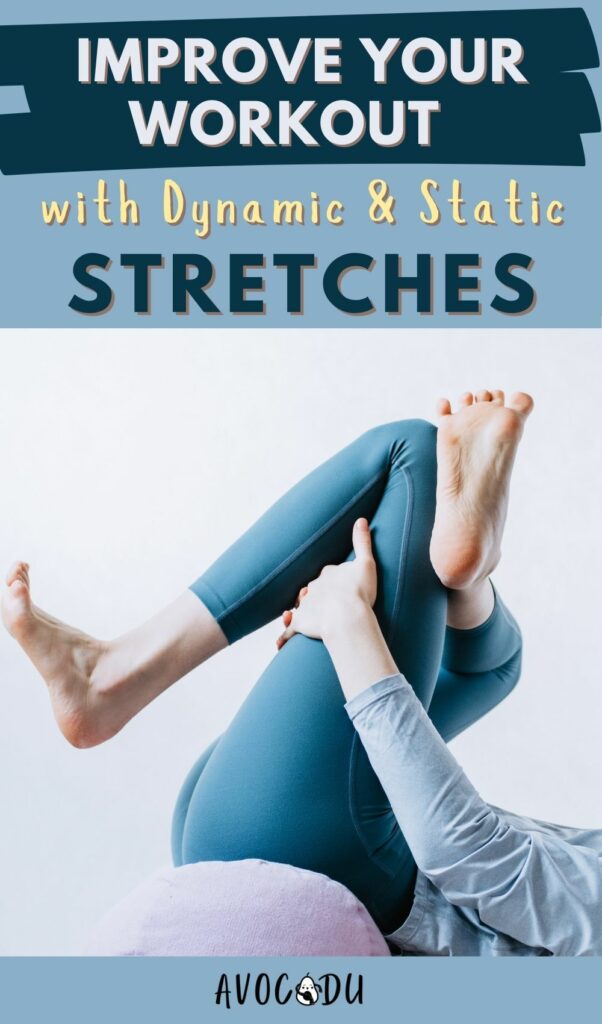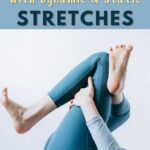Dynamic Stretches vs Static Stretches
Stretching is a crucial part of any fitness routine. It helps keep your body flexible, enhances your performance during physical activities, and aids in muscle recovery afterward.
Stretching is essential for both preparing your body for exercise and helping it recover afterward. It directly impacts how your muscles perform during activity and how they feel afterward.
But not all stretches are the same, and choosing the right type for the right time can make a significant difference.
You’ve probably heard the terms dynamic and static stretching before, but do you know what sets them apart?
In a nutshell, dynamic stretches involve active movement to prepare your muscles for exercise, while static stretches are all about holding a position to help your muscles relax and recover.
Each serves a specific purpose depending on whether you’re warming up or winding down.
Let’s take a deeper look at how each type of stretch works and when to use them so you can get the most out of your workouts.
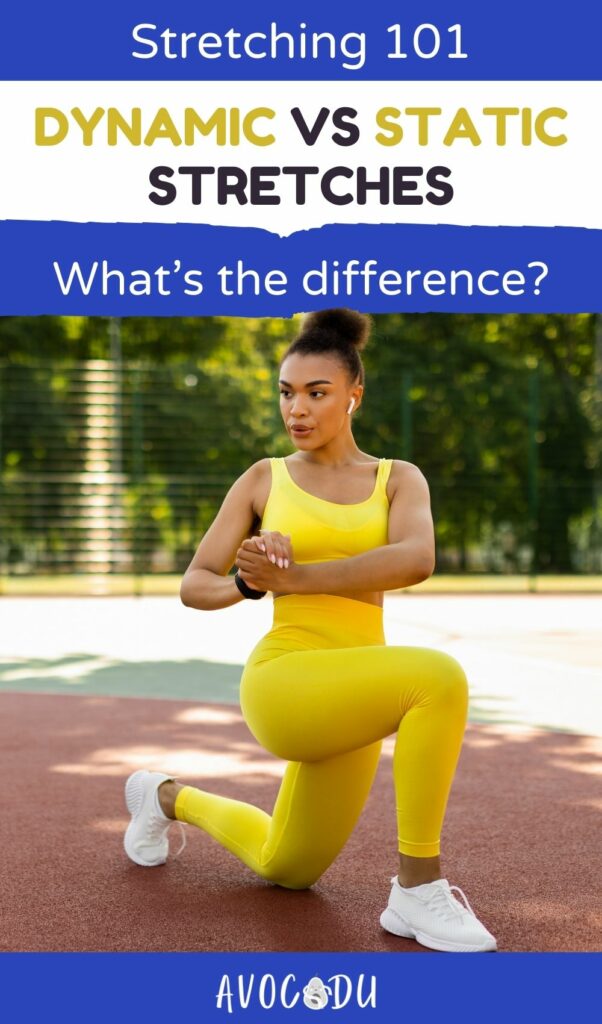
This post may contain affiliate links, which helps keep this content free. Please read our disclosure for more info.
What Are Dynamic Stretches?
Dynamic stretching involves active movements that engage your muscles and joints, taking them through a full range of motion.
These stretches are typically performed before a workout because they warm up your body, activate your muscles, and get everything ready for the activity ahead.
Unlike static stretches, which you hold in place, dynamic stretches are all about movement and flow, which is why they’re ideal for priming your body for action.
What makes dynamic stretching particularly effective is how it gradually raises your heart rate, increases blood flow, and gets your muscles firing.
This increased circulation means your muscles are more prepared to handle the demands of your workout. Dynamic stretches also help to loosen up stiff joints, which is key for improving overall mobility.
Here are a few examples of dynamic stretches you can easily incorporate into your routine:
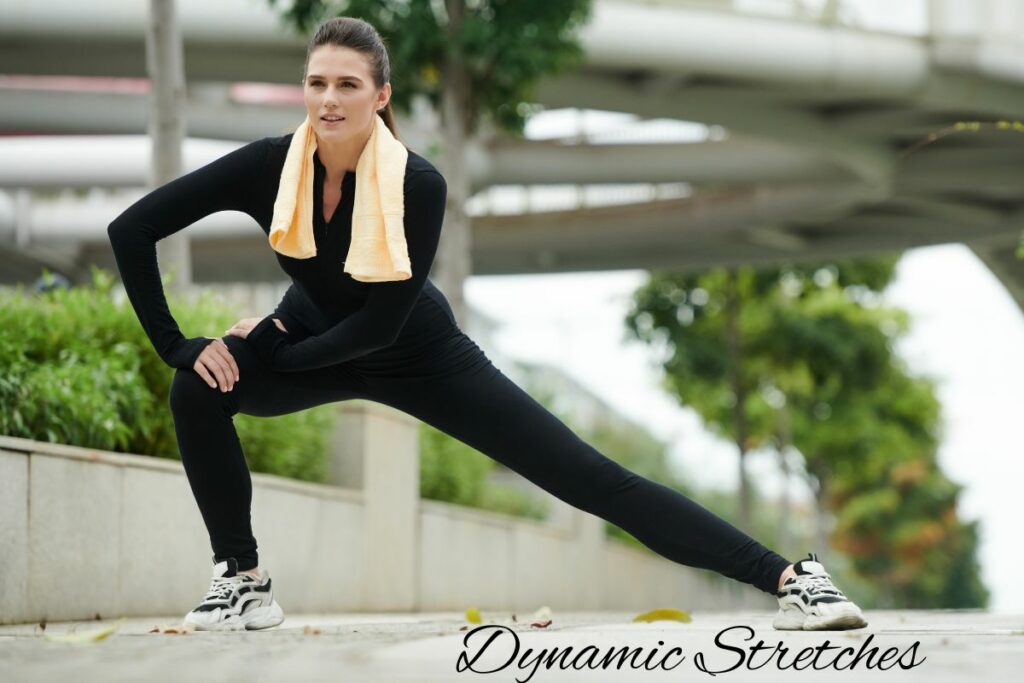
- Leg swings: Standing on one leg, swing the other leg forward and backward or side to side to engage your hip flexors, hamstrings, and glutes.
- Arm circles: Rotate your arms in large circles to warm up your shoulders and upper body.
- Walking lunges: Step forward into a deep lunge, then push off and bring the other leg forward into another lunge as you continue to move forward.
- High knees: March or jog in place, lifting your knees as high as possible to engage your core, hip flexors, and quadriceps.
- Butt kicks: Jog in place while kicking your heels up toward your glutes to warm up your hamstrings and improve leg mobility.
- Hip circles: Stand with your hands on your hips and rotate your hips in wide circles to loosen up your hip joints and lower back.
- Torso twists: Stand with your feet shoulder-width apart and twist your torso from side to side, engaging your core and stretching your lower back and obliques.
- World’s greatest stretch (my personal favorite!): Step into a deep lunge with one foot forward and drop your opposite hand to the floor. Rotate your torso toward your front leg, reaching your other hand toward the ceiling. This stretch targets the hips, hamstrings, and thoracic spine, improving mobility and flexibility.
- Side lunges: Step out to one side into a wide stance, bending one knee while keeping the other leg straight. Push your hips back and keep your chest up to engage your glutes, quads, and inner thighs. This stretch helps improve lateral mobility and balance.
The main goal of dynamic stretching is to improve mobility, balance, and coordination, making it perfect for sports or high-intensity activities where these elements are key.
Plus, by gradually increasing your heart rate and body temperature, you’re less likely to experience strains or injuries.
Think of dynamic stretching as a way to ease your body into movement, helping you perform better while reducing the chance of injury.
What Are Static Stretches?
Static stretching, on the other hand, focuses on holding a muscle in an elongated position for a certain amount of time, typically between 15 and 60 seconds.
Unlike dynamic stretches, which involve continuous movement, static stretches are performed while staying still.
These stretches are most effective after a workout or during a cool-down because they help your muscles relax, release tension, and gradually lengthen.
By holding these positions, you allow the muscle fibers to stretch out, which improves flexibility and reduces tightness.
Static stretching is not only about flexibility, reaching for your toes, or bending into positions. It’s an important way to signal to your body that the high-intensity activity is over, helping to lower your heart rate and kickstart recovery.
When your muscles are warm and more pliable after exercise, static stretching can be particularly useful in preventing stiffness and promoting overall flexibility over time.
Here are some examples of static stretches you can incorporate into your post-workout routine:
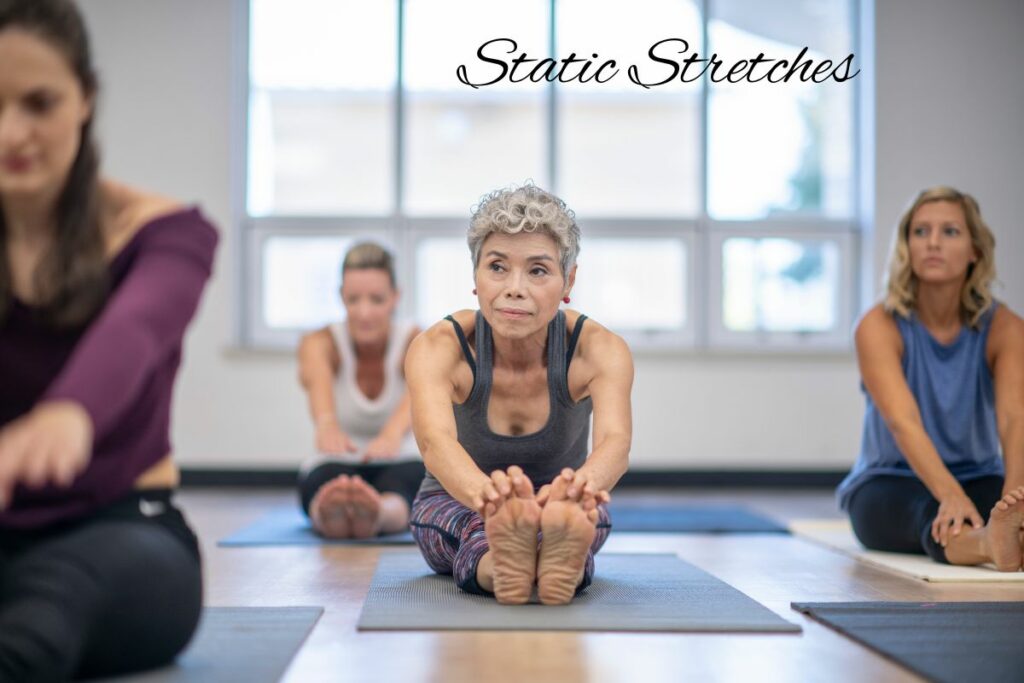
- Touching your toes: Stand with your feet together and bend forward at the hips, aiming to touch your toes or ankles. Hold this position to stretch your hamstrings and lower back.
- Quad stretch: Stand on one leg, pull your other foot up toward your glutes, and hold the stretch to target your quadriceps. Keep your knees together for the best stretch.
- Seated forward fold: Sit on the floor with your legs extended and reach for your toes, holding the position to stretch your hamstrings and lower back.
- Child’s pose: Kneel on the floor, sit back on your heels, and extend your arms forward while lowering your chest toward the floor. This stretch is great for your back, shoulders, and hips.
- Standing calf stretch: Stand with one leg behind you and press your heel into the floor, keeping your back leg straight. This helps to loosen up tight calf muscles.
- Butterfly stretch: Sit on the floor, bring the soles of your feet together, and gently press your knees toward the floor while holding your feet. This stretch targets the inner thighs and hips.
- Chest stretch: Stand tall and clasp your hands behind your back, then lift your arms slightly while pulling your shoulder blades together. This stretch opens up the chest and shoulders, which can get tight after upper-body workouts.
- Figure-four stretch: Lie on your back and cross one ankle over the opposite knee, then pull your bottom leg toward your chest. This stretch is effective for loosening up your glutes and hips.
Static stretching is an ideal way to improve flexibility over time while reducing muscle tension after a workout.
Holding these stretches also promotes relaxation and recovery, making it less likely that you’ll experience soreness or stiffness later on.
Incorporating static stretches into your cool-down routine can help ensure your muscles stay flexible and healthy.
Key Differences Between Dynamic and Static Stretches
Although both types of stretching are important for overall fitness, they serve distinct purposes in your routine. Here are the main differences:
Movement vs. Stillness
The most obvious difference between dynamic and static stretches is in how they’re performed. Dynamic stretches involve continuous, controlled movements.
They actively engage your muscles and joints, taking them through a full range of motion. The goal is to gradually increase your range and warm up your muscles in preparation for physical activity.
In contrast, static stretches are all about stillness. You move into a position that elongates a specific muscle group, holding that position for a set amount of time. The key here is relaxation and allowing the muscle to stretch out gently, without moving.
Timing: Warm-up vs. Cool-down
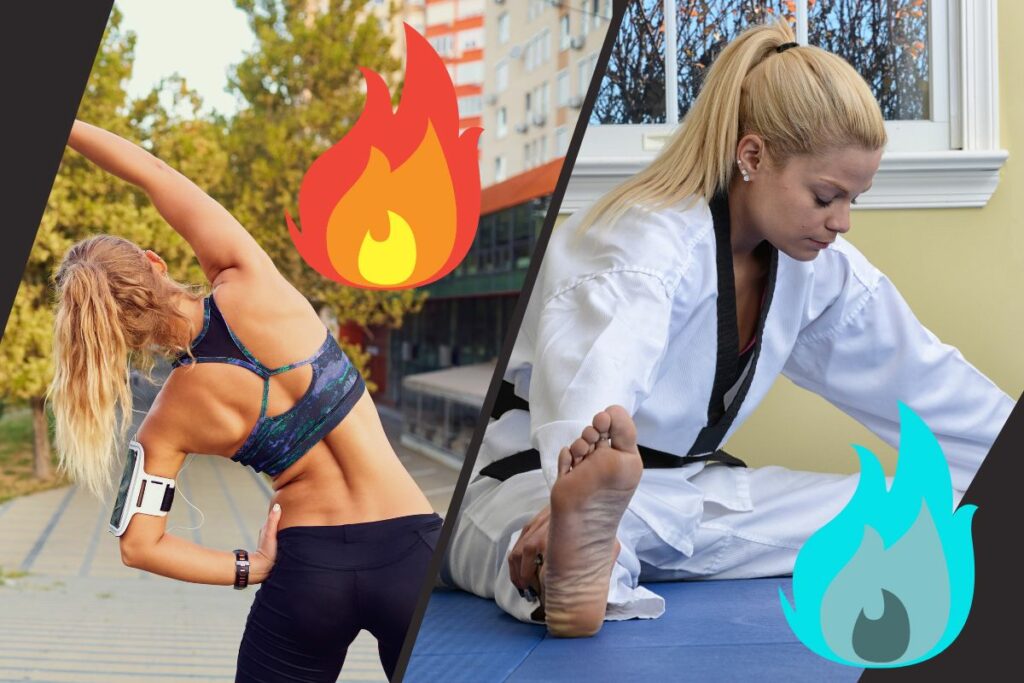
One of the biggest differences between dynamic and static stretching is when you use them.
Dynamic stretches are most effective before exercise. They’re designed to get your blood flowing and your muscles ready for action.
By warming up the muscles and joints, dynamic stretches help reduce the risk of injury and improve your overall performance during exercise.
On the other hand, static stretches are best saved for after a workout, when your muscles are already warm.
During a cool-down phase, static stretches help your muscles relax and return to their natural resting length, promoting flexibility and aiding in recovery.
Performance Effects
Another critical difference between the two types of stretching is their effect on your performance.
Dynamic stretching can enhance your performance by improving mobility, balance, and coordination.
By actively moving your muscles through their range of motion, you’re prepping them for the specific demands of your workout. Whether you’re about to sprint, squat, or play a sport, dynamic stretching gets your body ready for the activity ahead.
In contrast, static stretching can temporarily reduce power and strength if performed before exercise.
Holding a static stretch for too long before a workout can make your muscles feel looser, which might reduce their ability to generate force when you need it most.
This is why static stretches are better suited for the cool-down phase, where the focus shifts from performance to recovery.
Muscle Activation vs. Muscle Relaxation
Dynamic stretching is all about activating your muscles. By moving through various ranges of motion, you’re engaging and waking up your muscles to get them ready for physical exertion. It’s like flipping a switch to “on,” preparing your muscles for the upcoming workout or athletic performance.
Static stretching, however, is more about relaxation. You’re not trying to energize your muscles but rather let them relax and lengthen. By holding these stretches, you’re signaling to your muscles that it’s time to cool down and start the recovery process.
Injury Prevention
Both dynamic and static stretches play a role in preventing injuries, but in different ways.
Dynamic stretching helps by improving mobility and flexibility before your workout, reducing the likelihood of strains or sprains.
Static stretching, when done after exercise, helps prevent injury in the long term by improving flexibility and releasing tension that can build up in muscles after repetitive motion or high-intensity activity.
Common Mistakes and How to Avoid Them
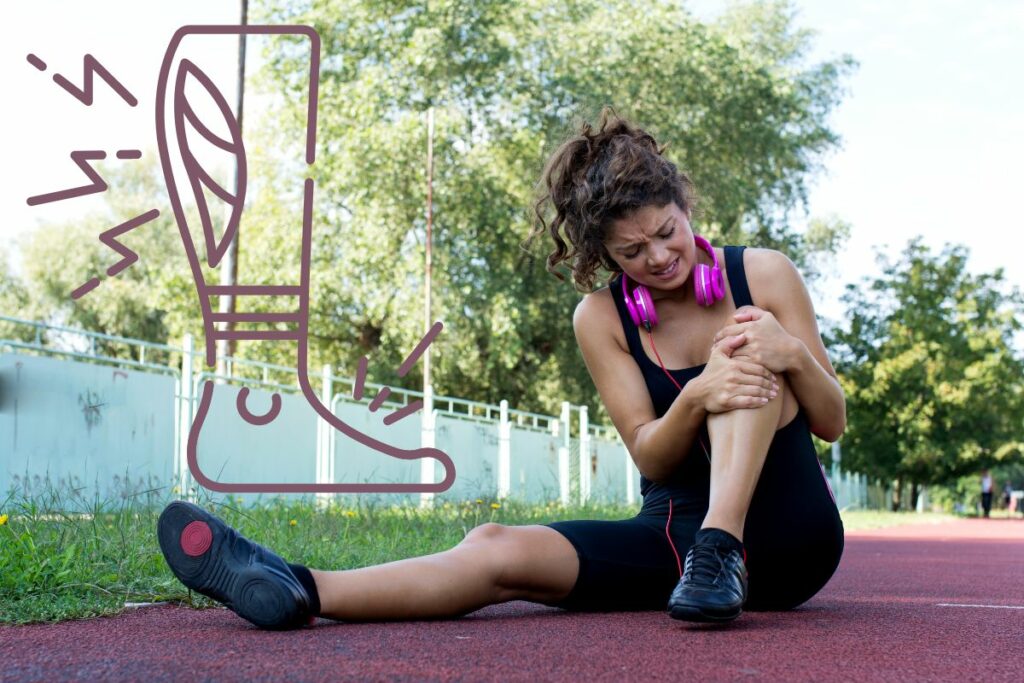
Stretching is crucial for maintaining flexibility and preventing injuries, but it’s easy to make mistakes that can lessen its effectiveness or even lead to injury. Here are a few common stretching mistakes and tips on how to avoid them:
- Using static stretches before a workout: Holding static stretches before exercise can actually reduce muscle strength and power, making it harder to perform at your best. This happens because static stretches temporarily relax the muscles, which isn’t ideal when you need them primed for action. Additionally, static stretching before exercise can increase the risk of injury since your muscles aren’t properly warmed up.
- Overstretching with dynamic stretches: While dynamic stretches involve movement, they should still be controlled and within your normal range of motion. Forcing a stretch too far can lead to muscle strains or joint injuries. The goal is to warm up your muscles, not to push them to their limit. Focus on smooth, controlled motions that gradually increase mobility without causing discomfort. Keep your form in check, and avoid bouncing or jerky movements, which can cause unnecessary strain.
- Skipping the cool-down: After a tough workout, it’s tempting to skip the cool-down and head straight for the shower, but this can be a big mistake. Your muscles need time to transition from a state of high activity to relaxation, and static stretches are an important part of that process. By skipping static stretches after exercise, you miss out on the benefits of improved flexibility and muscle recovery, which can leave you feeling stiff or sore the next day.
Incorporating Both Types of Stretching into Your Routine
The best approach is to combine both dynamic and static stretches into your routine. Use dynamic stretches to warm up and get your muscles moving before exercise, then follow up with static stretches to cool down afterward.
Here’s an example of how you can structure a balanced stretching routine:
- Pre-workout: Do 5-10 minutes of dynamic stretches (leg swings, arm circles, walking lunges).
- Post-workout: Spend 5-10 minutes holding static stretches for each major muscle group.
Maximizing Your Workout with the Right Stretch
Understanding the difference between dynamic and static stretches is key to getting the most out of your fitness routine.
Dynamic stretches are your go-to for warming up, getting your muscles ready for action, and improving mobility before exercise.
On the other hand, static stretches help your body wind down, promoting recovery, relaxation, and flexibility after your workout.
By incorporating both types of stretching at the right time, you can enhance your performance, reduce the risk of injury, and keep your muscles feeling great.
Whether you’re preparing for a workout or cooling down after one, the right stretches can make a big difference in how you feel and how well you perform.
